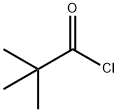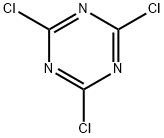Pivaloyl chloride
Synonym(s):2,2-Dimethylpropionyl chloride, Trimethylacetyl chloride;Pivaloyl chloride;Trimethylacetyl chloride
- CAS NO.:3282-30-2
- Empirical Formula: C5H9ClO
- Molecular Weight: 120.58
- MDL number: MFCD00000709
- EINECS: 221-921-6
- SAFETY DATA SHEET (SDS)
- Update Date: 2025-01-27 09:38:02

What is Pivaloyl chloride?
Chemical properties
Colorless to yellow liquid
The Uses of Pivaloyl chloride
Widely used N-acylating agent for amines,1 Schiff bases,2 and pyrrolidinones3 as well as O-acylating agent for alcohols,4 lactones,5 and saccharides.6
The Uses of Pivaloyl chloride
Trimethylacetyl chloride is used as a precursor in the preparation of tert-butyl peroxypivalate, guttiferon A derivatives, which is potential for the treatment of malaria. It is used as a raw material in the production of synthetic acidamide medicament and phenol ester medicament. In addition to this, it is used for the synthesis of active pharmaceutical ingredients such as aminobenzylpenicilin, cephalexin, cefazolin, dipivefrin and dipivalyl epinephrine. It is also used in heavy polymerization, N-acylating agent for amines, Schiff bases, pyrrolidinones as well as an O-acylating agent for alcohols, lactones and saccharides.
Synthesis Reference(s)
Tetrahedron Letters, 29, p. 4569, 1988 DOI: 10.1016/S0040-4039(00)80549-3
General Description
Colorless fuming liquid with a pungent odor. Boiling point 105-106°F. Density 0.979 g / cm3. Flash point 48°F (8°C). Very toxic by inhalation, ingestion or skin absorption. Fumes irritate the eyes and mucous membranes. Corrosive to most metals and tissue.
Air & Water Reactions
Highly flammable. Fumes in air. Reacts vigorously and exothermically with water to form trimethylacetic acid and corrosive hydrochloric acid; both acids corrode metals and tissue [AAR 1991].
Reactivity Profile
Pivaloyl chloride is acidic. Incompatible with bases (including amines), strong oxidizing agents, and alcohols. May react vigorously or explosively if mixed with diisopropyl ether or other ethers in the presence of trace amounts of metal salts [J. Haz. Mat., 1981, 4, 291].
Health Hazard
May cause toxic effects if inhaled or ingested/swallowed. Contact with substance may cause severe burns to skin and eyes. Fire will produce irritating, corrosive and/or toxic gases. Vapors may cause dizziness or suffocation. Runoff from fire control or dilution water may cause pollution.
Fire Hazard
Flammable/combustible material. May be ignited by heat, sparks or flames. Vapors may form explosive mixtures with air. Vapors may travel to source of ignition and flash back. Most vapors are heavier than air. They will spread along ground and collect in low or confined areas (sewers, basements, tanks). Vapor explosion hazard indoors, outdoors or in sewers. Runoff to sewer may create fire or explosion hazard. Containers may explode when heated. Many liquids are lighter than water.
Flammability and Explosibility
Flammable
Safety Profile
A corrosive irritant to skin, eyes, and mucous membranes. The liquid is flammable when exposed to heat, flame, or oxiduers. When heated to decomposition it emits toxic fumes of Cl-.
Purification Methods
First check the IR to see if OH bands are present. If absent, or present in small amounts, then redistil it under a moderate vacuum. If present in large amounts then treat it with oxalyl chloride or thionyl chloride and reflux for 2-3hours, evaporate and distil the residue. Strongly LACHRYMATORY -work in a fumecupboard. Store it in sealed ampoules under N2. [Traynham & Battiste J Org Chem 22 1551 1957, Grignard reactions: Whitmore et al. J Am Chem Soc 63 647 1941, Beilstein 2 IV 912.]
Properties of Pivaloyl chloride
| Melting point: | -56 °C |
| Boiling point: | 105-106 °C(lit.) |
| Density | 0.980 g/mL at 20 °C |
| vapor density | >1 (vs air) |
| vapor pressure | 36 mm Hg ( 20 °C) |
| refractive index | n |
| Flash point: | 48 °F |
| storage temp. | Store below +30°C. |
| solubility | Miscible with acetonitrile. |
| form | Liquid |
| color | Clear almost colorless to light pink |
| explosive limit | 1.9-7.4%(V) |
| Water Solubility | Hydrolysis |
| Sensitive | Moisture Sensitive |
| BRN | 385668 |
| Stability: | Hygroscopic, Moisture Sensitive, Volatile |
| CAS DataBase Reference | 3282-30-2(CAS DataBase Reference) |
| NIST Chemistry Reference | Propanoyl chloride, 2,2-dimethyl-(3282-30-2) |
| EPA Substance Registry System | Propanoyl chloride, 2,2-dimethyl- (3282-30-2) |
Safety information for Pivaloyl chloride
| Signal word | Danger |
| Pictogram(s) |
 Flame Flammables GHS02  Corrosion Corrosives GHS05  Skull and Crossbones Acute Toxicity GHS06 |
| GHS Hazard Statements |
H225:Flammable liquids H290:Corrosive to Metals H302:Acute toxicity,oral H314:Skin corrosion/irritation H330:Acute toxicity,inhalation |
| Precautionary Statement Codes |
P210:Keep away from heat/sparks/open flames/hot surfaces. — No smoking. P280:Wear protective gloves/protective clothing/eye protection/face protection. P301+P312:IF SWALLOWED: call a POISON CENTER or doctor/physician IF you feel unwell. P303+P361+P353:IF ON SKIN (or hair): Remove/Take off Immediately all contaminated clothing. Rinse SKIN with water/shower. P305+P351+P338:IF IN EYES: Rinse cautiously with water for several minutes. Remove contact lenses, if present and easy to do. Continuerinsing. |
Computed Descriptors for Pivaloyl chloride
| InChIKey | JVSFQJZRHXAUGT-UHFFFAOYSA-N |
Pivaloyl chloride manufacturer
JSK Chemicals
New Products
Indole Methyl Resin tert-butyl 9-methoxy-3-azaspiro[5.5]undecane-3-carboxylate Boc-His(Boc)-OH 2-CTC Resin 4-Chloro-7-tosy1-7Hpyrrolo[2,3-d]pyrimidine 5,7-Dibromo-1H-indole 2,5-dichloro-N-hydroxy-4,6-dimethylpyridine-3-carboximidamide 2,2-Dimethoxy-7-azaspiro[3.5]nonane hydrochloride 4-chloromethyl-5-methyl-1,3-dioxol-2-one (DMDO-Cl) R-2-BENZYLOXY PROPIONIC ACID 1,1’-CARBONYLDIIMIDAZOLE 1,1’-CARBONYLDI (1,2-4 TRIAZOLE) N-METHYL INDAZOLE-3-CARBOXYLIC ACID 4-((2-hydroxyethyl)thio)benzoic acid 1-(TERT-BUTOXYCARBONYL)-2-PYRROLIDINONE Methyl 6-methylnicotinate 3-Pyridineacrylic acid tert-Butyl carbazate TETRAHYDRO-2H-PYRAN-3-OL 2-((4-morpholinophenylamino) (methylthio) methylene) malononitrile 3-(4-morpholinophenylamino)-5-amino-1H-pyrazole-4-carbonitrile 2,4-dihydroxybenzaldehyde 1,3-Diethyl-1,3-Diphenylurea Methyl 2-methylquinoline-6-carboxylateRelated products of tetrahydrofuran








You may like
-
 Pivaloyl chloride 98%View Details
Pivaloyl chloride 98%View Details -
 Pivaloyl chloride 98%View Details
Pivaloyl chloride 98%View Details
3282-30-2 -
 3282-30-2 98%View Details
3282-30-2 98%View Details
3282-30-2 -
 3282-30-2 Pivaloyl chloride 98%View Details
3282-30-2 Pivaloyl chloride 98%View Details
3282-30-2 -
 Pivaloyl chloride CAS 3282-30-2View Details
Pivaloyl chloride CAS 3282-30-2View Details
3282-30-2 -
 Trimethylacetyl chloride, 99% CAS 3282-30-2View Details
Trimethylacetyl chloride, 99% CAS 3282-30-2View Details
3282-30-2 -
 Trimethylacetyl chloride 98 % ( Pivaloyl Chloride ) CAS 3282-30-2View Details
Trimethylacetyl chloride 98 % ( Pivaloyl Chloride ) CAS 3282-30-2View Details
3282-30-2 -
 Pivaloyl Chloride, Purity: 99%, 50kgView Details
Pivaloyl Chloride, Purity: 99%, 50kgView Details
3282-30-2
